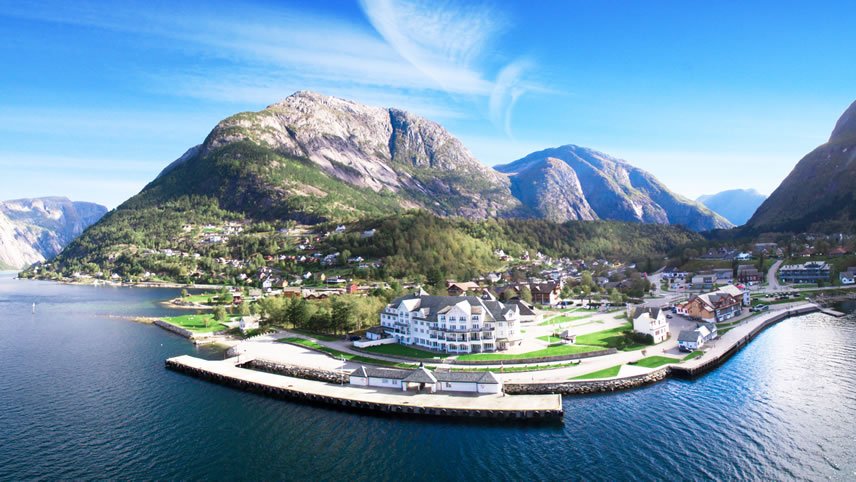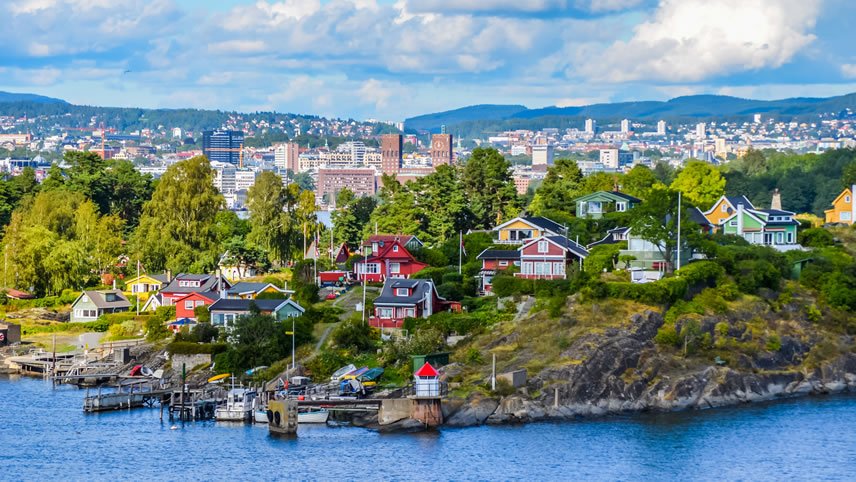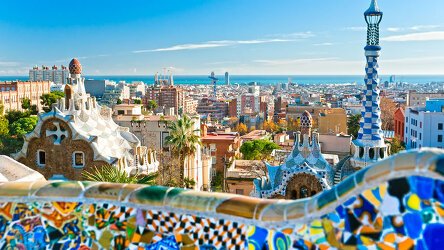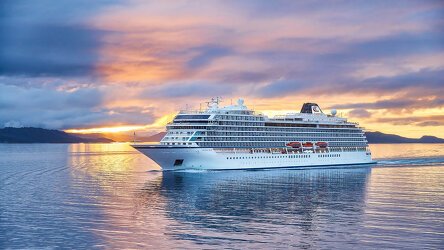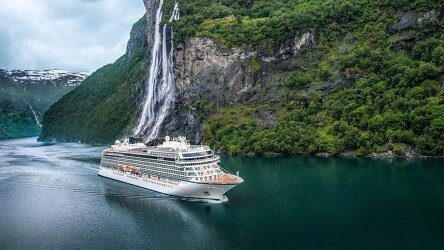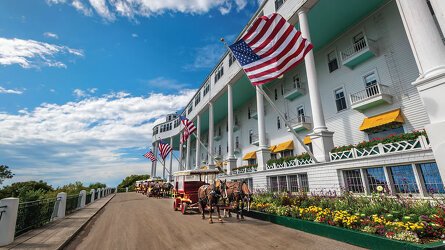Overview
Itinerary
Embark your ship and settle into your stateroom. Bergen is home to the Hanseatic League's only kontor (trading enclave) still in existence. Bryggen wharf, a row of timbered Hanseatic warehouses along a quaint quay, is a UNESCO World Heritage Site. Narrow wooden walkways are flanked by parallel rows of small, vibrantly painted buildings overlooking the picturesque Vågen Harbor. This is perhaps the most charming district of Bergen and a delight to explore, from its tight-knit community of workshops where artisans sell their wares to its cafés where freshly prepared smørbrød, or open-faced sandwiches, are on the menu.
The quaint village of Eidfjord is nestled in the heart of one of Norway's most scenic regions. From the Norwegian Sea, the waters of the expansive Hardangerfjord lead to the smaller Eidfjorden and to this charming mountain hamlet. Eidfjord embodies the Norway of every traveler's dream, the gateway to Hardangervidda, Europe's largest mountain plateau of soaring beauty. Wild reindeer roam here, among stunning, treeless moorlands dotted with pools, rivers, streams and the Vøringfossen Waterfall, a 550-foot cascade that plummets into the cavernous Måbødalen Canyon.
The coastal town of Haugesund is considered the birthplace of Norway. The Haraldshaugen Monument marks its unification into one kingdom in 872 and is said to be where the first king of Norway was buried. All the typical characteristics of a seaside Norwegian town are here: rustic timber houses, stunning sea views from the quays and magnificent vistas of fjords from the Steinsfjellet viewpoint. The region's cultural heritage is inextricably linked to the sea; built on the herring industry, surrounding charming towns have thrived on its success and continue to do so today.
Kristiansand boasts tidy streets, cozy harbors and small-town charm. The town's Viking past can be traced in the runestones at the Oddernes Church, built in 1040 and dedicated to St. Olaf, patron saint of Norway. In the 17th century, King Christian IV ordered the Christiansholm Fortress to be built to defend the newly founded city. Today, the edifice is adjacent to an inviting harborside boardwalk. The city's rich traditions are embodied in the old wooden houses of the Old Town and the stunning neo-Gothic cathedral.
Århus, located on Jutland's eastern coast along its eponymous bay, is Denmark's second-largest city. One of the country's oldest cities, with roots dating back to an 8th-century Viking settlement, Århus became a center for trade and prospered during the Middle Ages. Today, it is an eclectic mix of past and present. A bustling port and center for commerce and industry with a modern skyline, it still retains its old-world charms in Den Gamle By, or Old Town, a repository of medieval landmarks, including centuries-old timbered houses and the 13th-century Århus Cathedral.
Skagen is a charming old seaside village nestled amid pristine dunes, picturesque moors and long sand beaches. During the Middle Ages, Skagen was known for its herring catch, and remains a major fishing center today. With the introduction of the railway, a group of impressionist painters discovered the area's seascapes and soft evening light and journeyed here to found the Skagen Painters; their work is showcased at the small Skagens Museum. The lure of Skagen inspired royalty to visit: King Christian X was so taken with the setting that he built a summer residence here.
Oslo is one of Scandinavia's most vibrant cities, set on a splendid bay amid stunning fjords and hills. It was founded by a Norseman, King Harald III, and has grown over the centuries around the cherished Akershus Fortress. The city not only has a rich Viking past with its close ties to the sea, it also boasts an impressive artistic heritage. Perhaps its most famous painter is Edvard Munch, whose work The Scream is known the world over. But Gustav Vigeland's 200 or so sculptures are the most prominent works in the city, on full display throughout Vigeland Park.
Oslo is Norway's largest and most populous city. The city is nestled between the waters of Oslofjord and the sloping forestlands that stretch into the hinterlands, so a nature walk is never far away. Oslo is also home to many notable museums that celebrate the city's vibrant art scene and its Viking heritage. The Nobel Peace Center celebrates the legacy of Alfred Nobel, who bequeathed his fortune to establish what is considered the world's most prestigious award—the Nobel Peace Prize.
Gothenburg is a thriving university town of picturesque canals, parks and gardens. Founded under a royal charter of Swedish King Gustavus Adolphus II in 1621, it grew into a major port. In the 18th century, the city prospered from the trade of the Swedish East India Company. That successful period is reflected in the stunning neoclassical stone houses that remain around the city's canals. Today, a maritime and mercantile past is visible in Gothenburg's cultural institutions, from the Gothenburg Museum of Art's paintings to the several museums of navigation and seafaring.
Copenhagen charms visitors like a Danish fairy tale. Among the Baltic's most beautiful cities, it began as a fishing village and boasts more than 850 years of history. It has been an important Scandinavian port since the Viking Age and remains one of Europe's most enchanting places, thanks to Tivoli Gardens, the world's second-oldest amusement park, and The Little Mermaid statue sitting in the harbor at Langelinie. Grand palaces also grace the cityscape, including Amalienborg Palace, the royal winter residence, and Rosenborg Castle, home to the Danish Crown Jewels.
Founded by Charles XI in 1860, Karlskrona is a fine example of Sweden's Renaissance-style architecture. The Admiralty Church, built in 1685, is one of the town's prominent buildings, and the town's wooden church is the largest in Sweden. Karlskrona's maritime history can be seen throughout; it is a base for the Swedish Navy and its port was awarded UNESCO world Heritage status in 1998. The Naval Museum showcases the port's history and its exhibits include a submarine. The nearby Kungsholm Fortress is the world's oldest fort still in operation today.
Much of Gotland's landscape dates to the 6th century, when Vikings dominated the island. More Viking relics have been uncovered here than anywhere else in Sweden, making it a treasure trove of the era. Its strategic location bolstered the local economy when merchant ships of the Hanseatic League docked here for provisions or for trading. Visby grew into the most important city of the League, surpassing even Bergen in significance. Its two miles of defensive walls and 44 watchtowers are among the most remarkably preserved in Europe.
The Swedish-speaking city of Mariehamn is the capital of Åland, an autonomous territory under Finnish sovereignty. The archipelago spans approximately 6,700 islands and lies halfway between Finland and Sweden. The compact city center sits between two harbors and offers a number of restaurants, cafes and shops. A haven for outdoor activities, it is an ideal location to explore the region by land or by sea. The city's Viking heritage is a celebrated treasure; each year, Mariehamn hosts the annual Viking Market, one of the largest of its kind in Scandinavia.
Elegant Stockholm is nestled where Lake Mälaren's cobalt waters meet the Baltic. This stunning cultural capital extends over 14 islands linked by 57 graceful bridges. Hailed as one of the world's cleanest cities, it boasts numerous green parks. The well-preserved 13th-century Gamla Stan, or old town, boasts gabled merchant houses and an array of architectural styles, from the enormous baroque Stockholm Palace to the art nouveau Royal Dramatic Theater. Strandvägen is one of Europe's loveliest waterfront esplanades and the ideal place to sample some traditional smoked salmon.
Bid farewell to your fellow guests and journey home. Or spend more time exploring, perhaps joining one of our extensions.
Life Onboard Viking Saturn
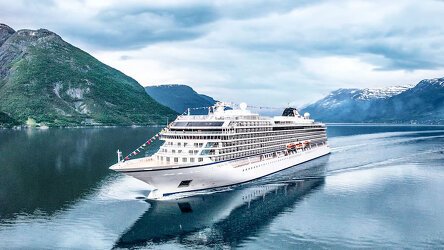
With her maiden voyage in 2023, the Viking Saturn is an all-veranda ship, part of a fleet of award winning, state of the art ships incorporating all the comforts & luxuries you would expect from Viking. Read more
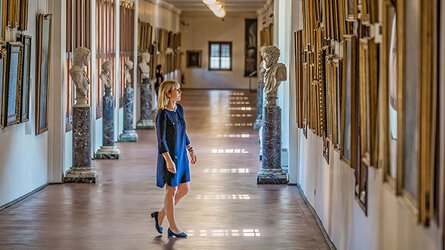
Viking are destination experts. With no casinos or children on board, you can be assured that the focus is firmly on enrichment and education. Read more
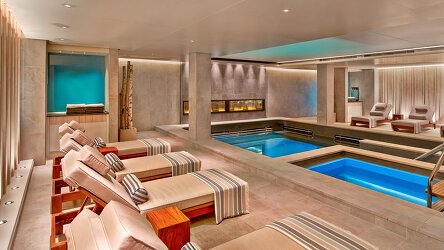
After a day of exploration or just to enhance the relaxation of a day at sea, the on-board Spa will leave you feeling recharged and revitalized. Read more

Viking offer eight on board dining options. Beer, wine and soft drinks are available with lunch and dinner at no additional charge of fee. Read more

Viking proudly includes all that you need and nothing you do not. A variety of features and services valued at $200 per person per day are standard inclusions in your cruise. Read more

Viking include one complimentary shore excursion in every port of call. Enjoy exclusive entry to cultural treasures and seldom-seen collections around the world. Read more

Brochure
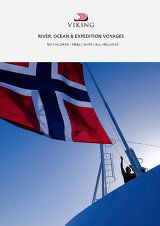
Viking River, Ocean & Expedition Voyages (2025-27)
Availability
 USD
Port charges, taxes and fees included.
USD
Port charges, taxes and fees included.
Tour & cruises prices are per person. Prices shown have savings applied, are subject to availability and may be withdrawn at any time without notice. Pricing and trip details are correct at this point in time, however are subject to confirmation at the time of booking and are subject to change by Viking. For cruise itineraries, cabin images are sourced from Viking. These should be treated as indicative only. Cabin inclusions, upholsteries and room layout may differ to the image(s) shown depending on the ship selected and your sailing dates.
